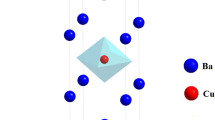Abstract
THE presence of apical oxygens (above or below the CuO2 planes) has been regarded as indispensable for the occurrence of hole-doped superconductivity in the high-transition-temperature (high-Tc) copper oxide superconductors1,2. We have opposed this view3,4, on the basis of studies in compounds such as (Ca, Sr)1 - xCuO2 - y and Srn+1CUnO2n+1+δ; however, our conclusions have been ques-tioned in subsequent work5,6. Here we provide strong evidence for hole-doped superconductivity in the absence of apical oxygens, by showing that Ca2CuO2Cl2 can be rendered superconducting by do** with sodium. The compound contains CuO2 planes as in La2CuO4, but all of the oxygen atoms at the apices of the CuO6 octahedra found in La2CuO4 are replaced by chlorine, and the lanthanum atoms by calcium7. The apparent difference in mass and electronic character between chlorine and oxygen might strongly affect the electronic structure of the CuO2 planes if the contributions of the apical atoms were significant. But we find hole-doped superconductivity in (Ca, Na)2CuO2Cl2 at rather high transition temperatures (26 K at maximum), which are only slightly less than those of doped La2CuO4 (ref. 8). This implies that the apical atoms do not play a significant role in the electron pairing mechanism leading to high-Tc superconductivity.
Similar content being viewed by others
References
Conradson, S. D. & Raistrick, I. D. Science 243, 1340–1343 (1989).
Ruani, G. et al. Physica C226, 101–105 (1994).
Azuma, M., Hiroi, Z., Takano, M., Bando, Y. & Takeda, Y. Nature 356, 775–776 (1992).
Hiroi, Z., Takano, M., Azuma, M. & Takeda, Y. Nature 364, 315–317 (1993).
Zhang, H. et al. Nature 370, 352–354 (1994).
Shimakawa, Y. et al. Physica C (in the press).
Müller-Buschbaum, H. Angew. Chem. int. Edn engl. 16, 674–687 (1977).
Bednorz, J. G. & Müller, K. A. Z. Phys. B64, 189–193 (1986).
Miller, L. L. et al. Phys. Rev. B41, 1921–1925 (1990).
Al-Mamouri, M., Edwards, P. P., Greaves, C. & Slaski, M. Nature 369, 382–384 (1994).
Hiroi, Z. & Takano, M. Paper presented at 4th Int. Conf. Materials & Mechanisms of Super-conductivity High Temperature Superconductors Grenoble, 5–9 July 1994).
Shannon, R. D. & Prewitt, C. T. Acta Crystallogr. B25, 925–946 (1969).
Presland, M. R., Tallon, J. L., Buckley, R. G., Liu, R. S. & Flower, N. E. Physica C176, 95–105 (1991).
Jorgensen, J. D., Dabrowski, B., Pei, S., Richards, D. R. & Hinks, D. G. Phys. Rev. B40, 2187–2199 (1989).
Fujimori, A. et al. Phys. Rev. B40, 7303–7306 (1989).
Author information
Authors and Affiliations
Rights and permissions
About this article
Cite this article
Hiroi, Z., Kobayashi, N. & Takano, M. Probable hole-doped superconductivity without apical oxygens in (Ca, Na)2CuO2CI2. Nature 371, 139–141 (1994). https://doi.org/10.1038/371139a0
Received:
Accepted:
Issue Date:
DOI: https://doi.org/10.1038/371139a0
- Springer Nature Limited
This article is cited by
-
Realizing metallicity in Sr2IrO4 thin films by high-pressure oxygen annealing
NPG Asia Materials (2023)
-
Fe-Based Superconducting Transition Temperature Modeling through Gaussian Process Regression
Journal of Low Temperature Physics (2021)
-
Expanding frontiers in materials chemistry and physics with multiple anions
Nature Communications (2018)
-
Visualizing the atomic-scale electronic structure of the Ca2CuO2Cl2 Mott insulator
Nature Communications (2013)
-
Quasiparticle interference and superconducting gap in Ca2−xNaxCuO2Cl2
Nature Physics (2007)





